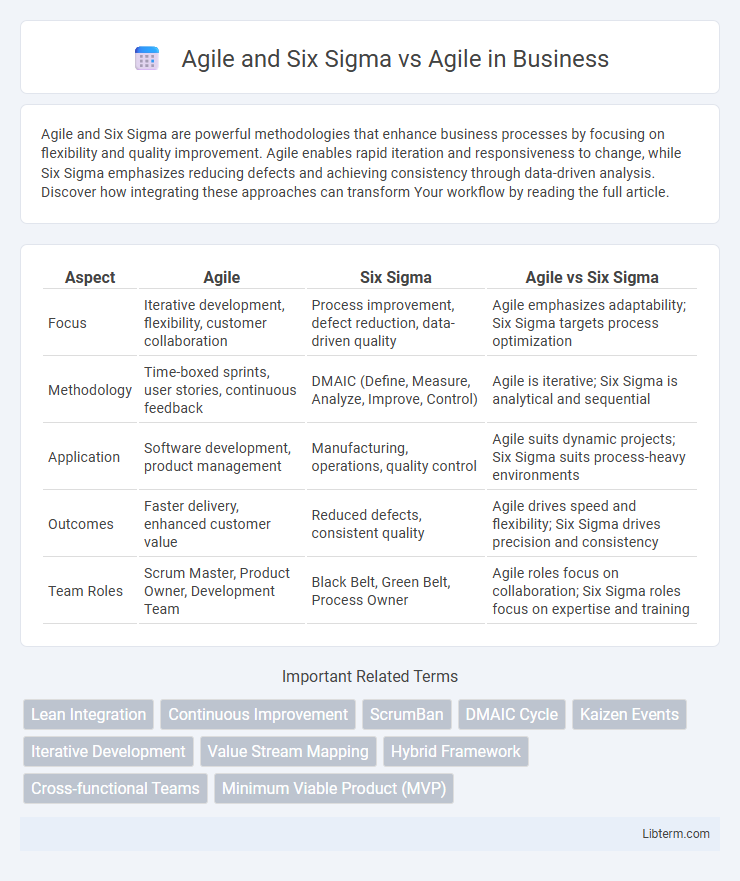Agile and Six Sigma are powerful methodologies that enhance business processes by focusing on flexibility and quality improvement. Agile enables rapid iteration and responsiveness to change, while Six Sigma emphasizes reducing defects and achieving consistency through data-driven analysis. Discover how integrating these approaches can transform Your workflow by reading the full article.
Table of Comparison
| Aspect | Agile | Six Sigma | Agile vs Six Sigma |
|---|---|---|---|
| Focus | Iterative development, flexibility, customer collaboration | Process improvement, defect reduction, data-driven quality | Agile emphasizes adaptability; Six Sigma targets process optimization |
| Methodology | Time-boxed sprints, user stories, continuous feedback | DMAIC (Define, Measure, Analyze, Improve, Control) | Agile is iterative; Six Sigma is analytical and sequential |
| Application | Software development, product management | Manufacturing, operations, quality control | Agile suits dynamic projects; Six Sigma suits process-heavy environments |
| Outcomes | Faster delivery, enhanced customer value | Reduced defects, consistent quality | Agile drives speed and flexibility; Six Sigma drives precision and consistency |
| Team Roles | Scrum Master, Product Owner, Development Team | Black Belt, Green Belt, Process Owner | Agile roles focus on collaboration; Six Sigma roles focus on expertise and training |
Understanding Agile: Principles and Practices
Agile embodies iterative development, customer collaboration, and adaptive planning, emphasizing responsiveness and continuous improvement. Six Sigma focuses on data-driven process improvement and defect reduction through DMAIC methodology, prioritizing precision and quality control. Combining Agile's flexibility with Six Sigma's analytical rigor enhances project efficiency and delivery excellence.
Six Sigma: Methodology and Core Concepts
Six Sigma is a data-driven methodology focused on reducing defects and improving process quality through DMAIC (Define, Measure, Analyze, Improve, Control) cycle and statistical analysis. Its core concepts include defect reduction, process capability, variation control, and continuous improvement using tools like control charts and root cause analysis. Agile, in contrast, emphasizes flexibility and iterative development, whereas Six Sigma prioritizes precision and process optimization for measurable quality gains.
Key Differences Between Agile and Six Sigma
Agile emphasizes iterative development, flexibility, and customer collaboration to deliver fast, adaptive solutions primarily in software and product development. Six Sigma focuses on reducing defects and improving process quality through data-driven methodologies and statistical analysis, often in manufacturing and operational processes. Key differences include Agile's adaptability and speed versus Six Sigma's structured, measurement-based approach to quality improvement.
Strengths and Limitations of Agile
Agile excels in flexibility and rapid iteration, making it ideal for projects with evolving requirements and a high need for stakeholder collaboration. Its strengths include adaptive planning, continuous feedback, and quick delivery cycles, but it may struggle with scalability and lacks the rigorous data-driven process control emphasized in Six Sigma. Limitations of Agile include potential scope creep, less predictability in timelines, and challenges in maintaining documentation and quality standards without structured methodologies like Six Sigma.
Benefits and Drawbacks of Six Sigma
Six Sigma offers rigorous process improvement through data-driven methods, yielding high precision in reducing defects and enhancing quality control. Its benefits include strong analytical tools and a structured approach ideal for complex manufacturing environments, but drawbacks involve lengthy implementation times and less flexibility compared to Agile's adaptability in dynamic project settings. While Agile emphasizes iterative development and quick responsiveness, Six Sigma's focus on statistical accuracy may slow innovation and limit rapid adjustments in fast-paced industries.
When to Use Agile vs Six Sigma
Agile is best suited for projects requiring flexibility, rapid iteration, and continuous feedback, particularly in software development and product innovation. Six Sigma excels in environments focused on reducing process variation and improving quality through data-driven, structured methods, ideal for manufacturing and operational efficiency. Choose Agile when speed and adaptability are critical, while Six Sigma is preferred for projects demanding precision and defect elimination.
Integrating Agile and Six Sigma: Is It Possible?
Integrating Agile and Six Sigma is feasible by combining Agile's flexibility and iterative development with Six Sigma's data-driven process improvement and quality control methodologies. Organizations can leverage Agile's rapid adaptation and Six Sigma's focus on reducing defects to enhance project outcomes and operational efficiency. Successful integration requires aligning Agile teams with Six Sigma's DMAIC framework to ensure continuous improvement without sacrificing speed or innovation.
Case Studies: Agile, Six Sigma, and Combined Approaches
Case studies reveal that Agile methodologies enhance software development flexibility and speed, while Six Sigma improves process quality through data-driven defect reduction. Combining Agile and Six Sigma leverages iterative development with rigorous quality control, resulting in accelerated delivery and higher customer satisfaction in industries like healthcare and manufacturing. Companies adopting the hybrid approach report up to 30% faster project completion and 25% fewer process errors compared to using either methodology alone.
Impact on Organizational Culture: Agile vs Six Sigma
Agile fosters a collaborative, adaptive organizational culture by emphasizing continuous feedback, cross-functional teams, and iterative progress, which encourages innovation and rapid response to change. Six Sigma cultivates a culture focused on data-driven decision-making, process standardization, and defect reduction, promoting consistency and operational excellence. Comparing Agile and Six Sigma, Agile impacts culture by enhancing flexibility and empowerment, while Six Sigma drives a culture of precision, discipline, and efficiency.
Choosing the Right Methodology for Your Project
Choosing the right methodology for your project depends on the desired outcomes and project complexity; Agile excels in fostering flexibility, rapid iteration, and customer collaboration in dynamic environments, while Six Sigma emphasizes data-driven quality improvement and process optimization in stability-focused projects. Combining Agile and Six Sigma can enhance both adaptability and precision, particularly in complex projects requiring continuous improvement and risk reduction. Evaluate project goals, team expertise, and stakeholder needs to determine whether Agile, Six Sigma, or a hybrid approach best supports your project's success.
Agile and Six Sigma Infographic

 libterm.com
libterm.com